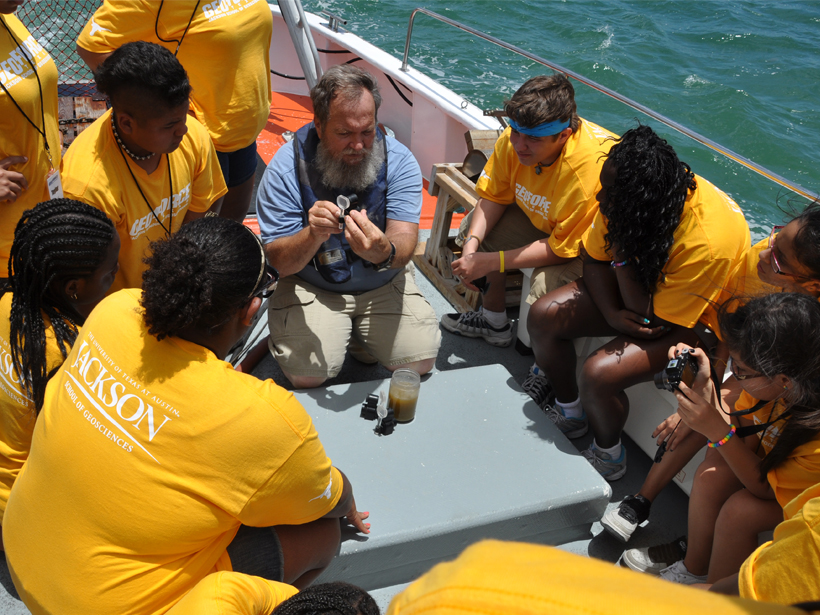Recent research on diversity indicates that a general underrepresentation of minorities in science and engineering becomes even more pronounced in the geosciences. The findings show also that despite efforts to attract more minorities into the geosciences, their representation has improved only incrementally for more than a decade.
Women, on the other hand, have increased their presence in the geosciences since 2004. Back then, women earned one out of every three doctoral degrees awarded in the geosciences; by 2014, the share of Ph.D.’s earned by women rose to 43%. Yet despite gains in educational attainment, women remain deeply underemployed in the geosciences, according to a recently released report from the National Center for Science and Engineering Statistics (NCSES), a division of the National Science Foundation. Across degree levels, women comprise only 23% of the geoscience workforce, the report found, although that percentage rises slightly for women with advanced degrees.
The geosciences, as defined by the report, include Earth, atmospheric, and ocean science.
Last week, NCSES offered an hour-long webinar about its report, titled “Women, Minorities, and Persons with Disabilities in Science and Engineering 2017.” At the webinar, Emilda B. Rivers, the deputy director of NCSES, discussed the findings of the report, which had been issued in January. The report draws on data from a variety of sources, including the 2014 American Community Survey, the 2015 National Survey of College Graduates, and degree completion data provided by the National Center for Education Statistics.
The State of Diversity in the Geosciences
Increases in race and ethnicity are just not happening in the geosciences.
Jackie Huntoon, the provost and vice president for academic affairs at Michigan Technological University in Houghton, has previously researched diversity in the geosciences and addresses it head-on in her current role. Increases in race and ethnicity are just not happening, she said.
The number of Ph.D.’s awarded in a field tells an important story because the number indicates what is happening at the leadership levels, according to Huntoon. As reported by NCSES, 861 Ph.D.’s were awarded in the geosciences in 2014, of which only 12 (1.4%) were earned by students categorized as “Black or African American.” Hispanics represented just 2.4% of the Ph.D. recipients.
In 2004, black or African American students earned 0.93% of the doctorates awarded in the geosciences, whereas Hispanics earned 1.9%. American Indians and Alaska Natives earned a meager 0.12% of doctorates in the field in 2014, down from 2004.
Huntoon explained that the proportion of whites among all U.S. geoscience doctorate graduates has stayed basically constant since 2004.
These numbers show that diversity programs may not have the cumulative effect that leaders in the field had hoped for, Huntoon remarked. Many factors may contribute to this lack of diversity, she added. Underrepresented students may not have the precollege exposure to the geosciences that their white counterparts receive, and underrepresented students lack community in the geosciences at many institutions, Huntoon explained. Often, they are the “lonely only,” she said: the only black student, the only Native American student, and so on.
Nicole LaDue, an assistant professor of geology and environmental geoscience at Northern Illinois University in DeKalb, added that many minority-serving institutions, like historically black colleges and universities, may lack the resources to hire sufficient geoscience faculty, further reducing exposure to the field.
LaDue highlighted that a 2014 study of geoscience websites found that most departments feature white males working outdoors, which might not accurately reflect the breadth of geoscience subdisciplines, she said.
Changing the Culture
Although the geosciences are struggling to increase diversity, some programs that pursue that aim have achieved recognized success.
Although the geosciences are struggling to increase diversity, some programs that pursue that aim have achieved recognized success. They include the Michigan AGEP Alliance (where AGEP stands for Alliances for Graduate Education and the Professoriate) and the Fisk-Vanderbilt Master’s-to-Ph.D. Bridge Program that focus on building community and mentoring for underrepresented students at the college level to foster their sense of belonging.
Another program, called GeoFORCE, received the Presidential Award for Excellence in Science, Mathematics, and Engineering Mentoring in 2015. It takes minority high school students from Houston and southwest Texas on weeklong geoscience field trips for four consecutive summers. Run by the Jackson School of Geosciences at the University of Texas at Austin, 100% of GeoFORCE participants have graduated from high school, with nearly 98% attending some level of college, said Sharon Mosher, Jackson’s dean. Of those attending college, Mosher continued, approximately 58% go on to major in a science, technology, engineering, and math (STEM) field.
Huntoon argues that diversity in science is something all scientists should embrace. Simply put, she said, the more voices we have at the table, the better and more comprehensive our solutions to 21st century problems will be.
—Aaron Sidder (email: [email protected]; @sidquan), Freelance Science Writer
Correction, 14 April 2017: An earlier version of this article included an abbreviated term for one of the categories of race and ethnicity used in the report by the National Center for Science and Engineering Statistics. This article has been updated to include the full wording of the term.
Citation:
Sidder, A. (2017), Geosciences make modest gains but still struggle with diversity, Eos, 98, https://doi.org/10.1029/2017EO071093. Published on 06 April 2017.
Text © 2017. The authors. CC BY-NC-ND 3.0
Except where otherwise noted, images are subject to copyright. Any reuse without express permission from the copyright owner is prohibited.

